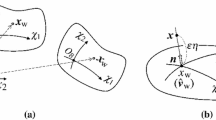Abstract
The problem of determining the slippage rate for a binary mixture of gases is considered on the basis of the linearized model equations of Hamel. It is shown that in a certain case the equations can be reduced to equations that are analogous to those applying to a one-component gas. We consider the flow of a gas mixture next to a plane wall in the absence of external forces. At distances from the wall exceeding the length of the mean free path of a molecule the Navier-Stokes equations for the mixture are valid. In the layer next to the wall, whose thickness is of the order of the mean free path of a molecule, it is necessary to solve the Boltzmann equation and to match the solutions at the boundary of the external and internal regions. As a result, the description of the flow in the Knudsen layer and the boundary conditions for the Navier-Stokes equations are obtained. This problem was first formulated for a single-component gas by Velander [1]. Yu. I. Yalamov, I. N. Ivchenko, and B. V. Deryagin [2]* have determined the slippage rate for a binary mixture in the case where the density of one of the gases is considerably less than that of the other. The temperature was assumed to be constant throughout the entire flow region. Krukov-type model equations were used as the original kinetic equations. Darrozes [3] considered the problem of determining the slippage rate for a binary mixture from the point of view of a sequential application of the method of asymptotic expansion for the Boltzmann equation, but he did not carry the process to a finish.
Similar content being viewed by others
Literature Cited
M. Deviep, Flow and Heat Exchange of Rarefied Gases [in Russian], Izd-vo Inostr. Lit., Moscow (1962).
Yu. I. Yalamov, I. N. Ivchenko, and B. V. Deryagin, “Calculation of the rate of diffusion slippage of a binary mixture,” Dokl. Akad. Nauk SSSR,180, No. 2 (1968).
J. Darrozes, “Quelques aspects sur la résolution approchée des equations de Boltzmannpour un mélange binaire de gaz,” J. La Recherche Aerospatiale, No. 128 (1969).
B. Hamel, “Kinetic model for binary gas mixtures,” Phys. Fluids,8, No. 3, 418–425 (1969).
Yu. Yu. Abramov and G. G. Gladush, “Flow of a rarefied gas next to a nonuniformly heated surface,” Izv. Akad. Nauk. Mekhan. Zhidk. i Gaza, No. 2, 20–29 (1970).
Yu. Yu. Abramov, “Approximate method of solution of the kinetic equation in the vicinity of a boundary. I. Slippage.” Teplofiz. Vys. Temp.,8, No. 4, 828–832 (1970).
Yu. Yu. Abramov, “Approximate method of solution of the kinetic equation in the vicinity of a boundary. II. Temperature Jump.” Teplofiz. Vys. Temp.,8, No. 5, 1013–1017 (1970).
M. N. Kogan, Dynamics of Rarefied Gases [in Russian], Nauka, Moscow (1967).
Additional information
Moscow. Translated from Izvestiya Akademii Nauk SSSR. Mekhanika Zhidkosti i Gaza, No. 2, pp. 98–104, March–April, 1972.
Rights and permissions
About this article
Cite this article
Zharov, V.A. Determination of the slippage rate for a binary mixture of gases. Fluid Dyn 7, 274–279 (1972). https://doi.org/10.1007/BF01186470
Received:
Issue Date:
DOI: https://doi.org/10.1007/BF01186470



